Project Proposal: Developing a KMS for DPI Crownlands - SDLC Approach
VerifiedAdded on 2023/06/10
|14
|3437
|414
Project
AI Summary
This project proposal outlines the development of a Knowledge Management System (KMS) for DPI Crownlands, addressing challenges related to changing legislation and operational dynamics. The proposal follows the System Development Lifecycle (SDLC), detailing phases such as planning and analysis (organizational context, problem statement, environmental analysis), system and requirements analysis (functional and non-functional requirements, feasibility studies), and system design (Agile development approach, system architecture). The proposed solution aims to improve transparency, streamline business processes, and enhance information sharing among stakeholders. The project includes cost and schedule feasibility analyses, a SWOT analysis, and a conclusion summarizing the benefits and recommendations. The report also includes references and appendices, offering a comprehensive approach to developing and implementing the KMS.

Student Details
PROJECT PROPOSAL
PROJECT PROPOSAL
Paraphrase This Document
Need a fresh take? Get an instant paraphrase of this document with our AI Paraphraser
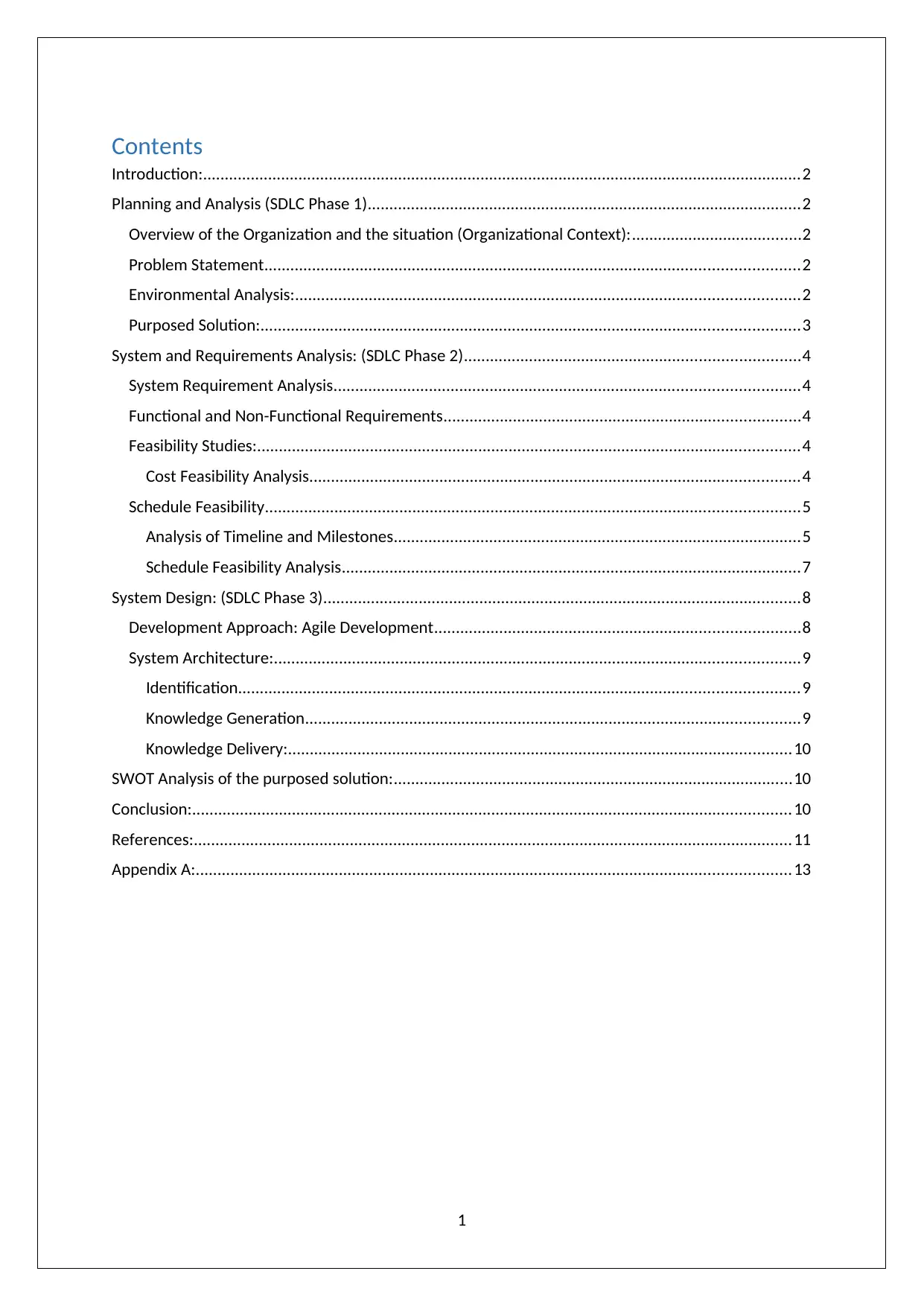
Contents
Introduction:..........................................................................................................................................2
Planning and Analysis (SDLC Phase 1)....................................................................................................2
Overview of the Organization and the situation (Organizational Context):.......................................2
Problem Statement...........................................................................................................................2
Environmental Analysis:....................................................................................................................2
Purposed Solution:............................................................................................................................3
System and Requirements Analysis: (SDLC Phase 2).............................................................................4
System Requirement Analysis...........................................................................................................4
Functional and Non-Functional Requirements..................................................................................4
Feasibility Studies:.............................................................................................................................4
Cost Feasibility Analysis.................................................................................................................4
Schedule Feasibility...........................................................................................................................5
Analysis of Timeline and Milestones..............................................................................................5
Schedule Feasibility Analysis..........................................................................................................7
System Design: (SDLC Phase 3)..............................................................................................................8
Development Approach: Agile Development....................................................................................8
System Architecture:.........................................................................................................................9
Identification.................................................................................................................................9
Knowledge Generation..................................................................................................................9
Knowledge Delivery:....................................................................................................................10
SWOT Analysis of the purposed solution:............................................................................................10
Conclusion:..........................................................................................................................................10
References:..........................................................................................................................................11
Appendix A:.........................................................................................................................................13
1
Introduction:..........................................................................................................................................2
Planning and Analysis (SDLC Phase 1)....................................................................................................2
Overview of the Organization and the situation (Organizational Context):.......................................2
Problem Statement...........................................................................................................................2
Environmental Analysis:....................................................................................................................2
Purposed Solution:............................................................................................................................3
System and Requirements Analysis: (SDLC Phase 2).............................................................................4
System Requirement Analysis...........................................................................................................4
Functional and Non-Functional Requirements..................................................................................4
Feasibility Studies:.............................................................................................................................4
Cost Feasibility Analysis.................................................................................................................4
Schedule Feasibility...........................................................................................................................5
Analysis of Timeline and Milestones..............................................................................................5
Schedule Feasibility Analysis..........................................................................................................7
System Design: (SDLC Phase 3)..............................................................................................................8
Development Approach: Agile Development....................................................................................8
System Architecture:.........................................................................................................................9
Identification.................................................................................................................................9
Knowledge Generation..................................................................................................................9
Knowledge Delivery:....................................................................................................................10
SWOT Analysis of the purposed solution:............................................................................................10
Conclusion:..........................................................................................................................................10
References:..........................................................................................................................................11
Appendix A:.........................................................................................................................................13
1
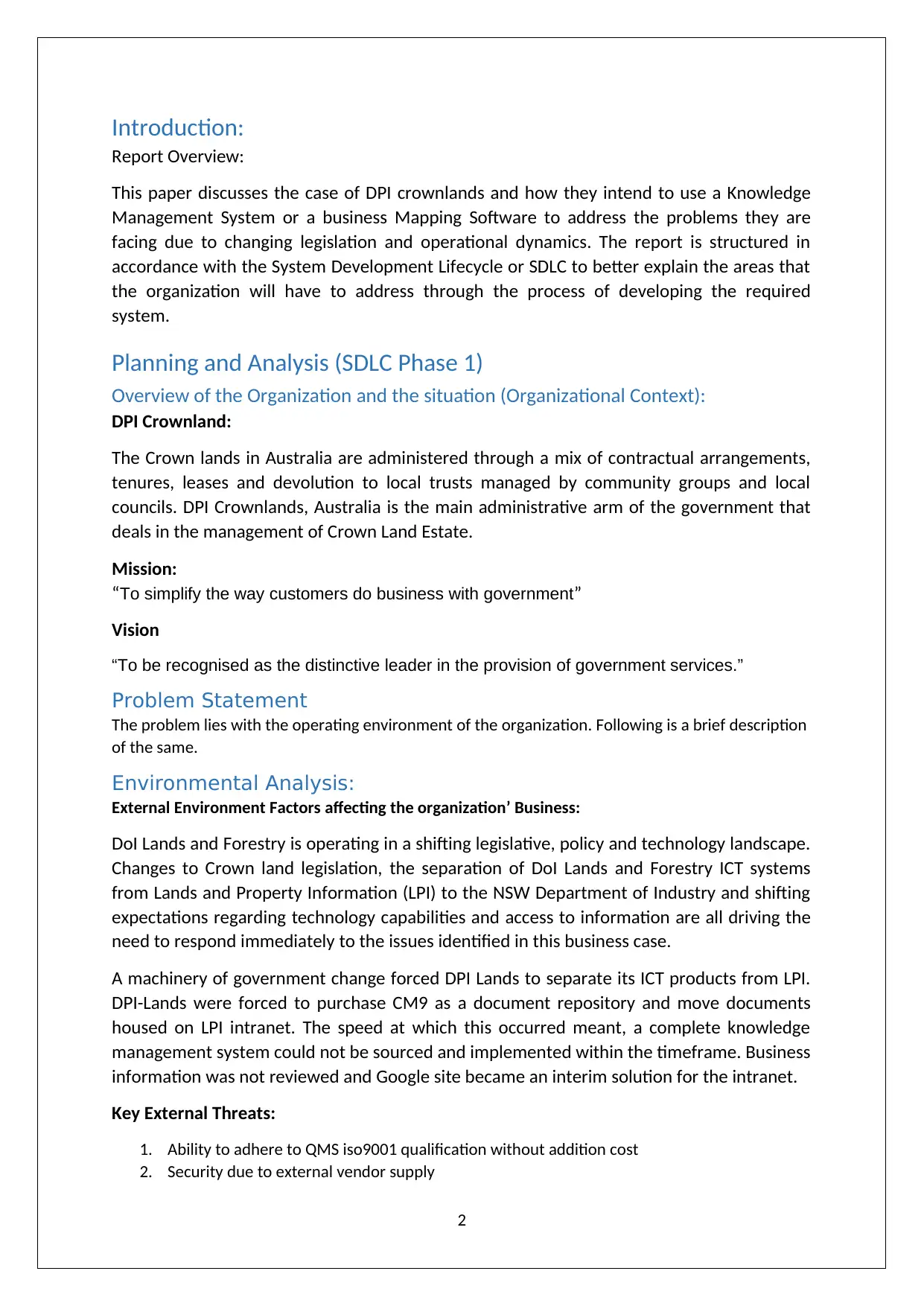
Introduction:
Report Overview:
This paper discusses the case of DPI crownlands and how they intend to use a Knowledge
Management System or a business Mapping Software to address the problems they are
facing due to changing legislation and operational dynamics. The report is structured in
accordance with the System Development Lifecycle or SDLC to better explain the areas that
the organization will have to address through the process of developing the required
system.
Planning and Analysis (SDLC Phase 1)
Overview of the Organization and the situation (Organizational Context):
DPI Crownland:
The Crown lands in Australia are administered through a mix of contractual arrangements,
tenures, leases and devolution to local trusts managed by community groups and local
councils. DPI Crownlands, Australia is the main administrative arm of the government that
deals in the management of Crown Land Estate.
Mission:
“To simplify the way customers do business with government”
Vision
“To be recognised as the distinctive leader in the provision of government services.”
Problem Statement
The problem lies with the operating environment of the organization. Following is a brief description
of the same.
Environmental Analysis:
External Environment Factors affecting the organization’ Business:
DoI Lands and Forestry is operating in a shifting legislative, policy and technology landscape.
Changes to Crown land legislation, the separation of DoI Lands and Forestry ICT systems
from Lands and Property Information (LPI) to the NSW Department of Industry and shifting
expectations regarding technology capabilities and access to information are all driving the
need to respond immediately to the issues identified in this business case.
A machinery of government change forced DPI Lands to separate its ICT products from LPI.
DPI-Lands were forced to purchase CM9 as a document repository and move documents
housed on LPI intranet. The speed at which this occurred meant, a complete knowledge
management system could not be sourced and implemented within the timeframe. Business
information was not reviewed and Google site became an interim solution for the intranet.
Key External Threats:
1. Ability to adhere to QMS iso9001 qualification without addition cost
2. Security due to external vendor supply
2
Report Overview:
This paper discusses the case of DPI crownlands and how they intend to use a Knowledge
Management System or a business Mapping Software to address the problems they are
facing due to changing legislation and operational dynamics. The report is structured in
accordance with the System Development Lifecycle or SDLC to better explain the areas that
the organization will have to address through the process of developing the required
system.
Planning and Analysis (SDLC Phase 1)
Overview of the Organization and the situation (Organizational Context):
DPI Crownland:
The Crown lands in Australia are administered through a mix of contractual arrangements,
tenures, leases and devolution to local trusts managed by community groups and local
councils. DPI Crownlands, Australia is the main administrative arm of the government that
deals in the management of Crown Land Estate.
Mission:
“To simplify the way customers do business with government”
Vision
“To be recognised as the distinctive leader in the provision of government services.”
Problem Statement
The problem lies with the operating environment of the organization. Following is a brief description
of the same.
Environmental Analysis:
External Environment Factors affecting the organization’ Business:
DoI Lands and Forestry is operating in a shifting legislative, policy and technology landscape.
Changes to Crown land legislation, the separation of DoI Lands and Forestry ICT systems
from Lands and Property Information (LPI) to the NSW Department of Industry and shifting
expectations regarding technology capabilities and access to information are all driving the
need to respond immediately to the issues identified in this business case.
A machinery of government change forced DPI Lands to separate its ICT products from LPI.
DPI-Lands were forced to purchase CM9 as a document repository and move documents
housed on LPI intranet. The speed at which this occurred meant, a complete knowledge
management system could not be sourced and implemented within the timeframe. Business
information was not reviewed and Google site became an interim solution for the intranet.
Key External Threats:
1. Ability to adhere to QMS iso9001 qualification without addition cost
2. Security due to external vendor supply
2
⊘ This is a preview!⊘
Do you want full access?
Subscribe today to unlock all pages.

Trusted by 1+ million students worldwide
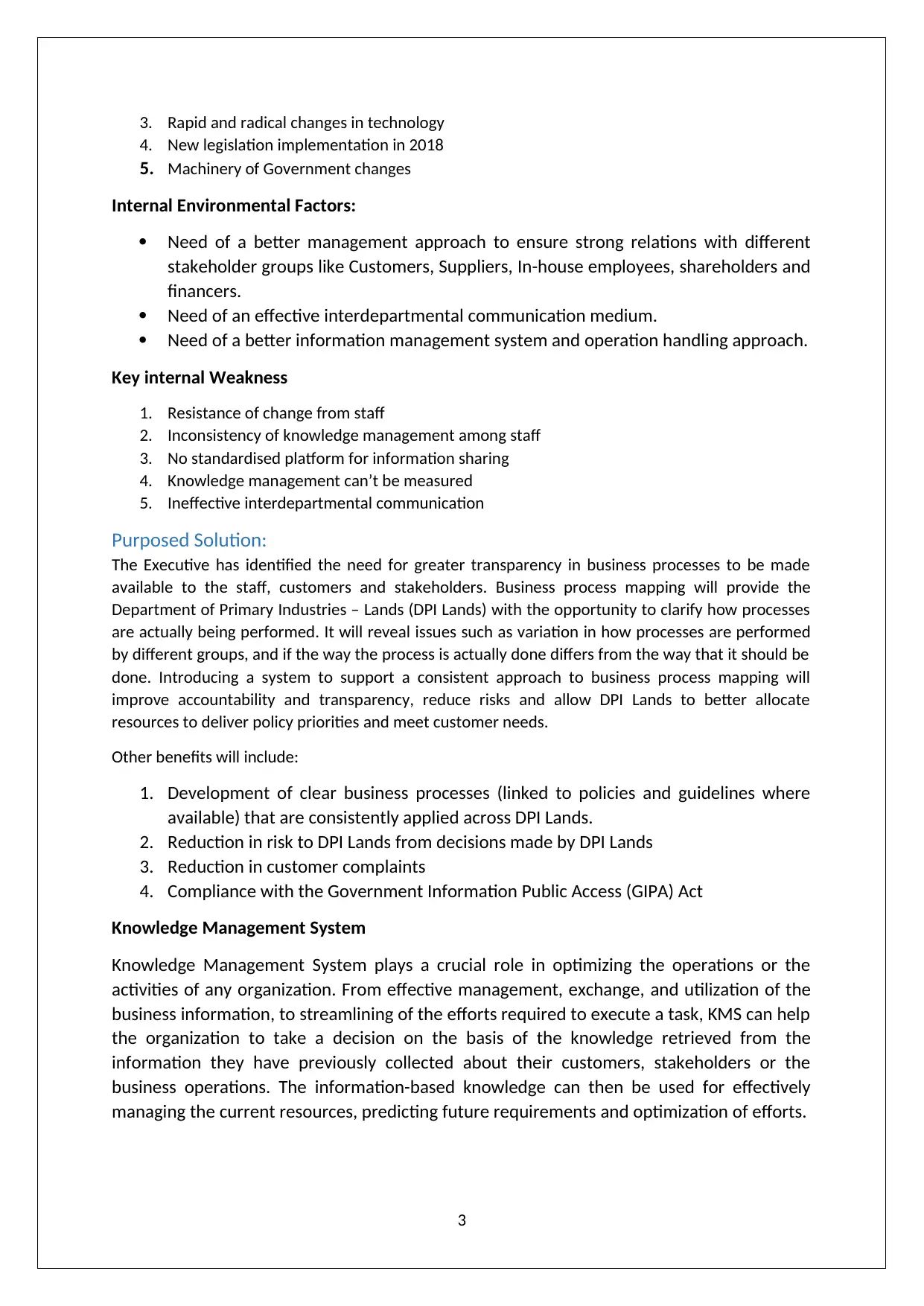
3. Rapid and radical changes in technology
4. New legislation implementation in 2018
5. Machinery of Government changes
Internal Environmental Factors:
Need of a better management approach to ensure strong relations with different
stakeholder groups like Customers, Suppliers, In-house employees, shareholders and
financers.
Need of an effective interdepartmental communication medium.
Need of a better information management system and operation handling approach.
Key internal Weakness
1. Resistance of change from staff
2. Inconsistency of knowledge management among staff
3. No standardised platform for information sharing
4. Knowledge management can’t be measured
5. Ineffective interdepartmental communication
Purposed Solution:
The Executive has identified the need for greater transparency in business processes to be made
available to the staff, customers and stakeholders. Business process mapping will provide the
Department of Primary Industries – Lands (DPI Lands) with the opportunity to clarify how processes
are actually being performed. It will reveal issues such as variation in how processes are performed
by different groups, and if the way the process is actually done differs from the way that it should be
done. Introducing a system to support a consistent approach to business process mapping will
improve accountability and transparency, reduce risks and allow DPI Lands to better allocate
resources to deliver policy priorities and meet customer needs.
Other benefits will include:
1. Development of clear business processes (linked to policies and guidelines where
available) that are consistently applied across DPI Lands.
2. Reduction in risk to DPI Lands from decisions made by DPI Lands
3. Reduction in customer complaints
4. Compliance with the Government Information Public Access (GIPA) Act
Knowledge Management System
Knowledge Management System plays a crucial role in optimizing the operations or the
activities of any organization. From effective management, exchange, and utilization of the
business information, to streamlining of the efforts required to execute a task, KMS can help
the organization to take a decision on the basis of the knowledge retrieved from the
information they have previously collected about their customers, stakeholders or the
business operations. The information-based knowledge can then be used for effectively
managing the current resources, predicting future requirements and optimization of efforts.
3
4. New legislation implementation in 2018
5. Machinery of Government changes
Internal Environmental Factors:
Need of a better management approach to ensure strong relations with different
stakeholder groups like Customers, Suppliers, In-house employees, shareholders and
financers.
Need of an effective interdepartmental communication medium.
Need of a better information management system and operation handling approach.
Key internal Weakness
1. Resistance of change from staff
2. Inconsistency of knowledge management among staff
3. No standardised platform for information sharing
4. Knowledge management can’t be measured
5. Ineffective interdepartmental communication
Purposed Solution:
The Executive has identified the need for greater transparency in business processes to be made
available to the staff, customers and stakeholders. Business process mapping will provide the
Department of Primary Industries – Lands (DPI Lands) with the opportunity to clarify how processes
are actually being performed. It will reveal issues such as variation in how processes are performed
by different groups, and if the way the process is actually done differs from the way that it should be
done. Introducing a system to support a consistent approach to business process mapping will
improve accountability and transparency, reduce risks and allow DPI Lands to better allocate
resources to deliver policy priorities and meet customer needs.
Other benefits will include:
1. Development of clear business processes (linked to policies and guidelines where
available) that are consistently applied across DPI Lands.
2. Reduction in risk to DPI Lands from decisions made by DPI Lands
3. Reduction in customer complaints
4. Compliance with the Government Information Public Access (GIPA) Act
Knowledge Management System
Knowledge Management System plays a crucial role in optimizing the operations or the
activities of any organization. From effective management, exchange, and utilization of the
business information, to streamlining of the efforts required to execute a task, KMS can help
the organization to take a decision on the basis of the knowledge retrieved from the
information they have previously collected about their customers, stakeholders or the
business operations. The information-based knowledge can then be used for effectively
managing the current resources, predicting future requirements and optimization of efforts.
3
Paraphrase This Document
Need a fresh take? Get an instant paraphrase of this document with our AI Paraphraser
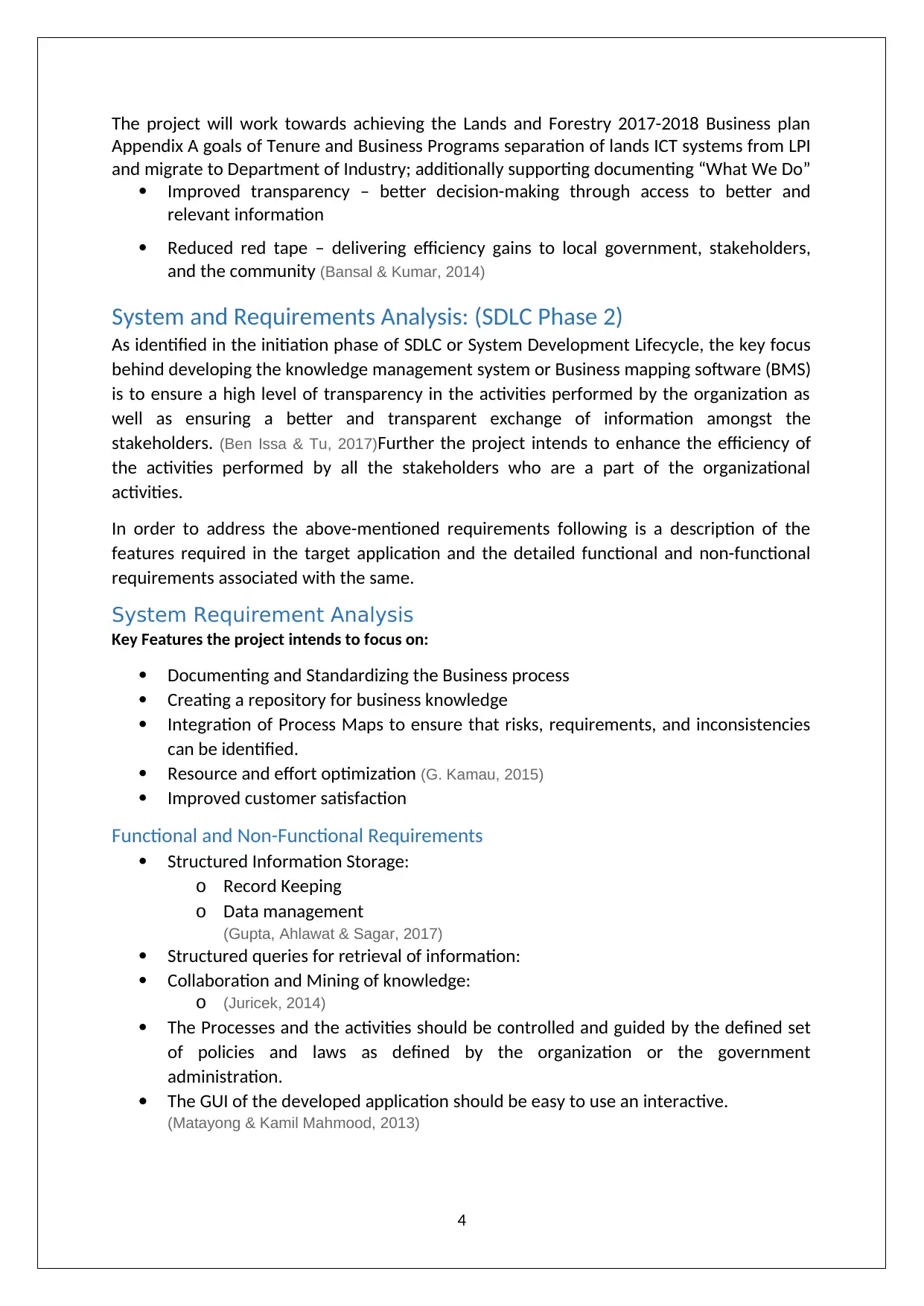
The project will work towards achieving the Lands and Forestry 2017-2018 Business plan
Appendix A goals of Tenure and Business Programs separation of lands ICT systems from LPI
and migrate to Department of Industry; additionally supporting documenting “What We Do”
Improved transparency – better decision-making through access to better and
relevant information
Reduced red tape – delivering efficiency gains to local government, stakeholders,
and the community (Bansal & Kumar, 2014)
System and Requirements Analysis: (SDLC Phase 2)
As identified in the initiation phase of SDLC or System Development Lifecycle, the key focus
behind developing the knowledge management system or Business mapping software (BMS)
is to ensure a high level of transparency in the activities performed by the organization as
well as ensuring a better and transparent exchange of information amongst the
stakeholders. (Ben Issa & Tu, 2017)Further the project intends to enhance the efficiency of
the activities performed by all the stakeholders who are a part of the organizational
activities.
In order to address the above-mentioned requirements following is a description of the
features required in the target application and the detailed functional and non-functional
requirements associated with the same.
System Requirement Analysis
Key Features the project intends to focus on:
Documenting and Standardizing the Business process
Creating a repository for business knowledge
Integration of Process Maps to ensure that risks, requirements, and inconsistencies
can be identified.
Resource and effort optimization (G. Kamau, 2015)
Improved customer satisfaction
Functional and Non-Functional Requirements
Structured Information Storage:
o Record Keeping
o Data management
(Gupta, Ahlawat & Sagar, 2017)
Structured queries for retrieval of information:
Collaboration and Mining of knowledge:
o (Juricek, 2014)
The Processes and the activities should be controlled and guided by the defined set
of policies and laws as defined by the organization or the government
administration.
The GUI of the developed application should be easy to use an interactive.
(Matayong & Kamil Mahmood, 2013)
4
Appendix A goals of Tenure and Business Programs separation of lands ICT systems from LPI
and migrate to Department of Industry; additionally supporting documenting “What We Do”
Improved transparency – better decision-making through access to better and
relevant information
Reduced red tape – delivering efficiency gains to local government, stakeholders,
and the community (Bansal & Kumar, 2014)
System and Requirements Analysis: (SDLC Phase 2)
As identified in the initiation phase of SDLC or System Development Lifecycle, the key focus
behind developing the knowledge management system or Business mapping software (BMS)
is to ensure a high level of transparency in the activities performed by the organization as
well as ensuring a better and transparent exchange of information amongst the
stakeholders. (Ben Issa & Tu, 2017)Further the project intends to enhance the efficiency of
the activities performed by all the stakeholders who are a part of the organizational
activities.
In order to address the above-mentioned requirements following is a description of the
features required in the target application and the detailed functional and non-functional
requirements associated with the same.
System Requirement Analysis
Key Features the project intends to focus on:
Documenting and Standardizing the Business process
Creating a repository for business knowledge
Integration of Process Maps to ensure that risks, requirements, and inconsistencies
can be identified.
Resource and effort optimization (G. Kamau, 2015)
Improved customer satisfaction
Functional and Non-Functional Requirements
Structured Information Storage:
o Record Keeping
o Data management
(Gupta, Ahlawat & Sagar, 2017)
Structured queries for retrieval of information:
Collaboration and Mining of knowledge:
o (Juricek, 2014)
The Processes and the activities should be controlled and guided by the defined set
of policies and laws as defined by the organization or the government
administration.
The GUI of the developed application should be easy to use an interactive.
(Matayong & Kamil Mahmood, 2013)
4
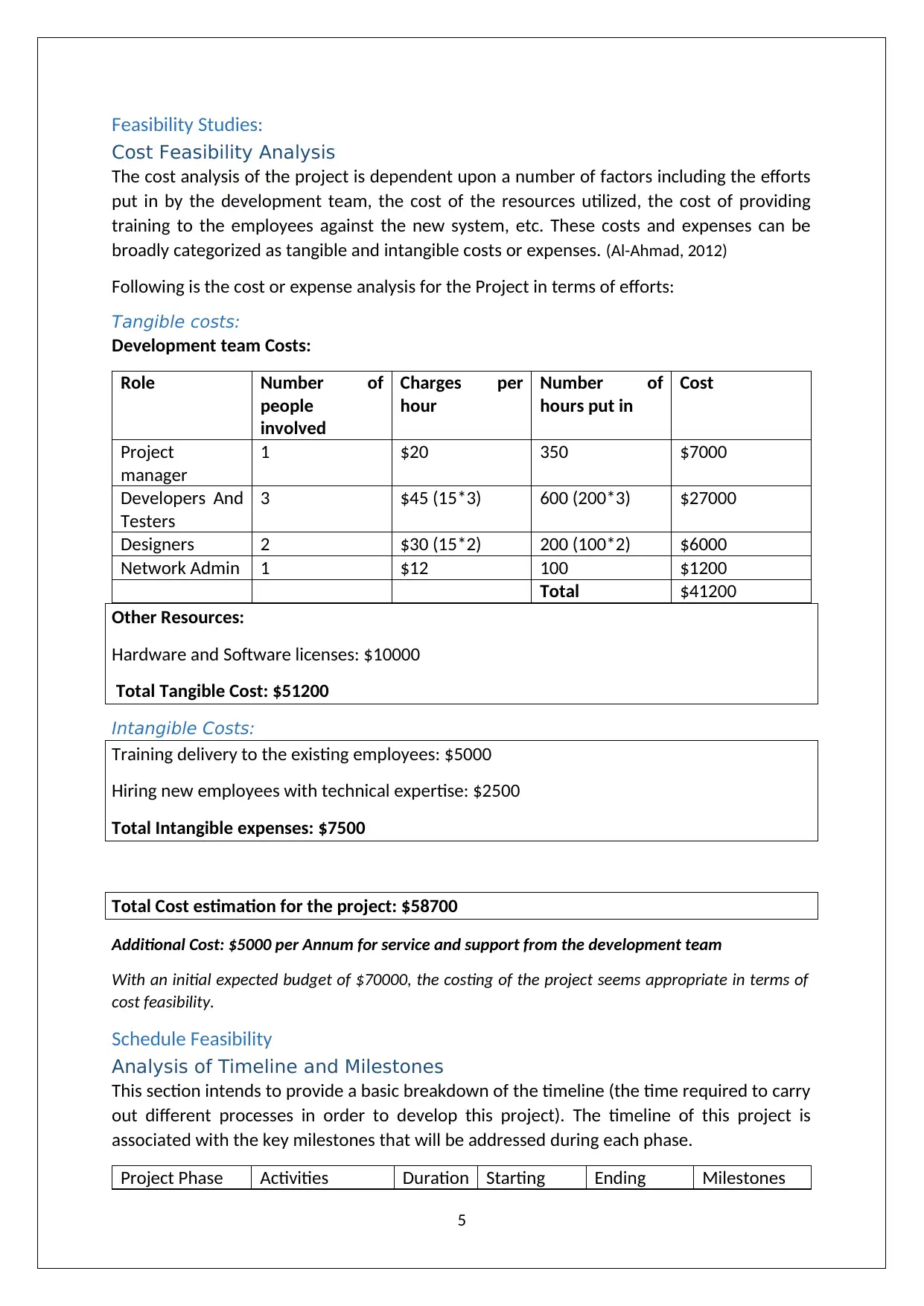
Feasibility Studies:
Cost Feasibility Analysis
The cost analysis of the project is dependent upon a number of factors including the efforts
put in by the development team, the cost of the resources utilized, the cost of providing
training to the employees against the new system, etc. These costs and expenses can be
broadly categorized as tangible and intangible costs or expenses. (Al-Ahmad, 2012)
Following is the cost or expense analysis for the Project in terms of efforts:
Tangible costs:
Development team Costs:
Role Number of
people
involved
Charges per
hour
Number of
hours put in
Cost
Project
manager
1 $20 350 $7000
Developers And
Testers
3 $45 (15*3) 600 (200*3) $27000
Designers 2 $30 (15*2) 200 (100*2) $6000
Network Admin 1 $12 100 $1200
Total $41200
Other Resources:
Hardware and Software licenses: $10000
Total Tangible Cost: $51200
Intangible Costs:
Training delivery to the existing employees: $5000
Hiring new employees with technical expertise: $2500
Total Intangible expenses: $7500
Total Cost estimation for the project: $58700
Additional Cost: $5000 per Annum for service and support from the development team
With an initial expected budget of $70000, the costing of the project seems appropriate in terms of
cost feasibility.
Schedule Feasibility
Analysis of Timeline and Milestones
This section intends to provide a basic breakdown of the timeline (the time required to carry
out different processes in order to develop this project). The timeline of this project is
associated with the key milestones that will be addressed during each phase.
Project Phase Activities Duration Starting Ending Milestones
5
Cost Feasibility Analysis
The cost analysis of the project is dependent upon a number of factors including the efforts
put in by the development team, the cost of the resources utilized, the cost of providing
training to the employees against the new system, etc. These costs and expenses can be
broadly categorized as tangible and intangible costs or expenses. (Al-Ahmad, 2012)
Following is the cost or expense analysis for the Project in terms of efforts:
Tangible costs:
Development team Costs:
Role Number of
people
involved
Charges per
hour
Number of
hours put in
Cost
Project
manager
1 $20 350 $7000
Developers And
Testers
3 $45 (15*3) 600 (200*3) $27000
Designers 2 $30 (15*2) 200 (100*2) $6000
Network Admin 1 $12 100 $1200
Total $41200
Other Resources:
Hardware and Software licenses: $10000
Total Tangible Cost: $51200
Intangible Costs:
Training delivery to the existing employees: $5000
Hiring new employees with technical expertise: $2500
Total Intangible expenses: $7500
Total Cost estimation for the project: $58700
Additional Cost: $5000 per Annum for service and support from the development team
With an initial expected budget of $70000, the costing of the project seems appropriate in terms of
cost feasibility.
Schedule Feasibility
Analysis of Timeline and Milestones
This section intends to provide a basic breakdown of the timeline (the time required to carry
out different processes in order to develop this project). The timeline of this project is
associated with the key milestones that will be addressed during each phase.
Project Phase Activities Duration Starting Ending Milestones
5
⊘ This is a preview!⊘
Do you want full access?
Subscribe today to unlock all pages.

Trusted by 1+ million students worldwide
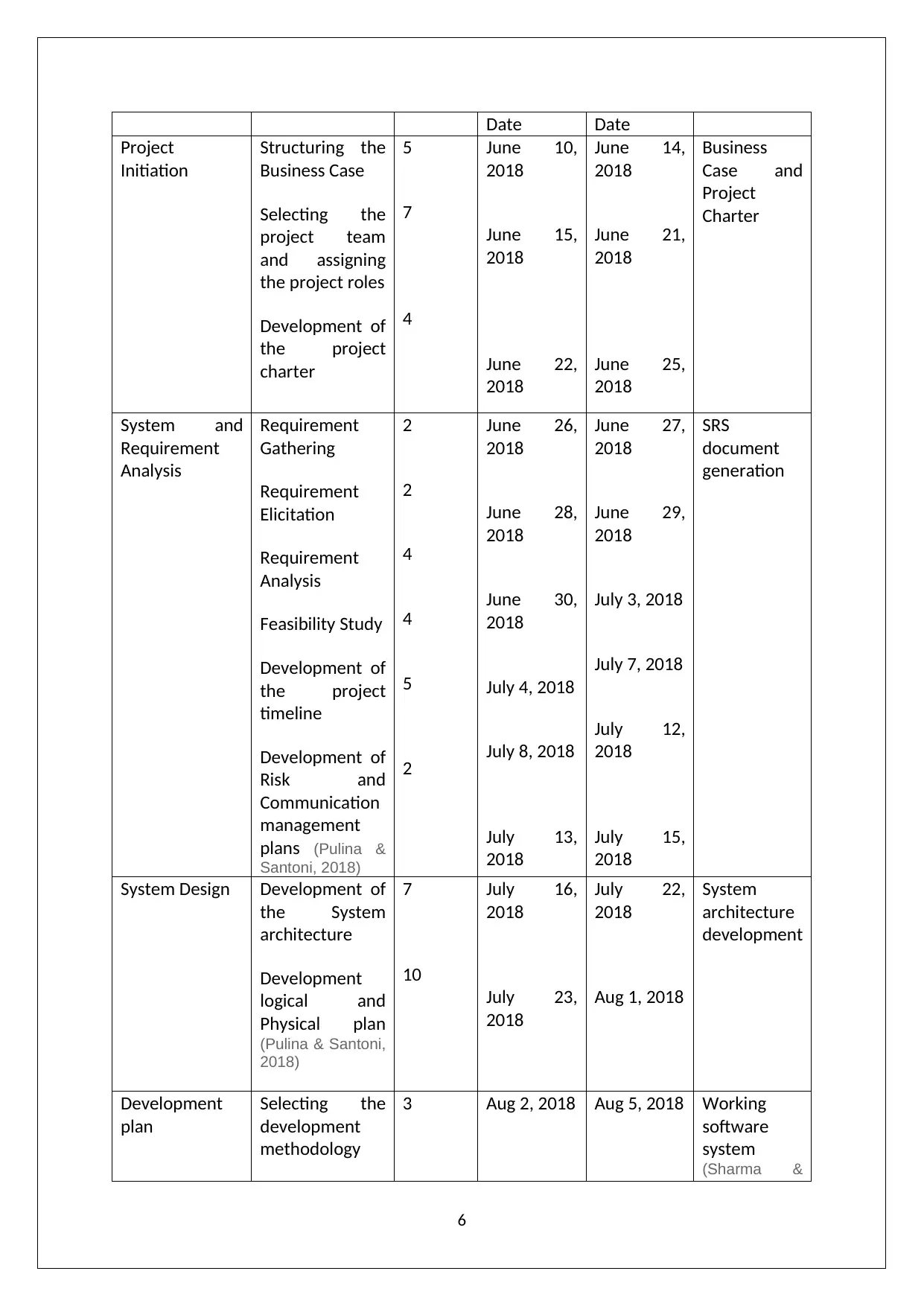
Date Date
Project
Initiation
Structuring the
Business Case
Selecting the
project team
and assigning
the project roles
Development of
the project
charter
5
7
4
June 10,
2018
June 15,
2018
June 22,
2018
June 14,
2018
June 21,
2018
June 25,
2018
Business
Case and
Project
Charter
System and
Requirement
Analysis
Requirement
Gathering
Requirement
Elicitation
Requirement
Analysis
Feasibility Study
Development of
the project
timeline
Development of
Risk and
Communication
management
plans (Pulina &
Santoni, 2018)
2
2
4
4
5
2
June 26,
2018
June 28,
2018
June 30,
2018
July 4, 2018
July 8, 2018
July 13,
2018
June 27,
2018
June 29,
2018
July 3, 2018
July 7, 2018
July 12,
2018
July 15,
2018
SRS
document
generation
System Design Development of
the System
architecture
Development
logical and
Physical plan
(Pulina & Santoni,
2018)
7
10
July 16,
2018
July 23,
2018
July 22,
2018
Aug 1, 2018
System
architecture
development
Development
plan
Selecting the
development
methodology
3 Aug 2, 2018 Aug 5, 2018 Working
software
system
(Sharma &
6
Project
Initiation
Structuring the
Business Case
Selecting the
project team
and assigning
the project roles
Development of
the project
charter
5
7
4
June 10,
2018
June 15,
2018
June 22,
2018
June 14,
2018
June 21,
2018
June 25,
2018
Business
Case and
Project
Charter
System and
Requirement
Analysis
Requirement
Gathering
Requirement
Elicitation
Requirement
Analysis
Feasibility Study
Development of
the project
timeline
Development of
Risk and
Communication
management
plans (Pulina &
Santoni, 2018)
2
2
4
4
5
2
June 26,
2018
June 28,
2018
June 30,
2018
July 4, 2018
July 8, 2018
July 13,
2018
June 27,
2018
June 29,
2018
July 3, 2018
July 7, 2018
July 12,
2018
July 15,
2018
SRS
document
generation
System Design Development of
the System
architecture
Development
logical and
Physical plan
(Pulina & Santoni,
2018)
7
10
July 16,
2018
July 23,
2018
July 22,
2018
Aug 1, 2018
System
architecture
development
Development
plan
Selecting the
development
methodology
3 Aug 2, 2018 Aug 5, 2018 Working
software
system
(Sharma &
6
Paraphrase This Document
Need a fresh take? Get an instant paraphrase of this document with our AI Paraphraser

Coding the
backend of the
System
Creating the GUI
for the target
system
18
12
Aug 6, 2018
Aug 24,
2018
Aug 23,
2018
Sep 4, 2018
Singh, 2015)
Integration and
Testing
Performing Unit
Testing
Integration of
the modules
Performing
integration
testing
Performing user
Acceptance
testing
4
4
4
7
Sep 5, 2018
Sep 9, 2018
Sep 13,
2018
Sep 17,
2018
Sep 8, 2018
Sep 12,
2018
Sep 16,
2018
Sep 23,
2018
Testing and
User
accepted
Implementation Implementing
the system at
the client side
or DoI unit
2 Sep 24,
2018
Sep 25,
2018
Project
delivery
Operation and
Maintenance
Providing After
implementation
training
(Sharma & Singh,
2015)
Delivering User
guides and
training
resources
7
1
Sep 26,
2018
Oct 4, 2018
Oct 3, 2018
Oct 4, 2018
Training
delivery
(Sharma &
Singh, 2015)
Schedule Feasibility Analysis
As evident above the project is estimated to take a time of 100 days (+ - 10%); In addition to
the activities mentioned in the SDLC process, the organization will also have to spend time
on activities such as:
Hiring New Employees or Workforce with Technical Expertise
Train the staff as per the required technical expertise, which will further extend the
deadline for the project.
An estimated time period of 10-15 days is expected for the same, hence taking the
total timeline to 120 days of 4 months.
The identified timeline for the project seems relevant considering the scale of the project.
7
backend of the
System
Creating the GUI
for the target
system
18
12
Aug 6, 2018
Aug 24,
2018
Aug 23,
2018
Sep 4, 2018
Singh, 2015)
Integration and
Testing
Performing Unit
Testing
Integration of
the modules
Performing
integration
testing
Performing user
Acceptance
testing
4
4
4
7
Sep 5, 2018
Sep 9, 2018
Sep 13,
2018
Sep 17,
2018
Sep 8, 2018
Sep 12,
2018
Sep 16,
2018
Sep 23,
2018
Testing and
User
accepted
Implementation Implementing
the system at
the client side
or DoI unit
2 Sep 24,
2018
Sep 25,
2018
Project
delivery
Operation and
Maintenance
Providing After
implementation
training
(Sharma & Singh,
2015)
Delivering User
guides and
training
resources
7
1
Sep 26,
2018
Oct 4, 2018
Oct 3, 2018
Oct 4, 2018
Training
delivery
(Sharma &
Singh, 2015)
Schedule Feasibility Analysis
As evident above the project is estimated to take a time of 100 days (+ - 10%); In addition to
the activities mentioned in the SDLC process, the organization will also have to spend time
on activities such as:
Hiring New Employees or Workforce with Technical Expertise
Train the staff as per the required technical expertise, which will further extend the
deadline for the project.
An estimated time period of 10-15 days is expected for the same, hence taking the
total timeline to 120 days of 4 months.
The identified timeline for the project seems relevant considering the scale of the project.
7
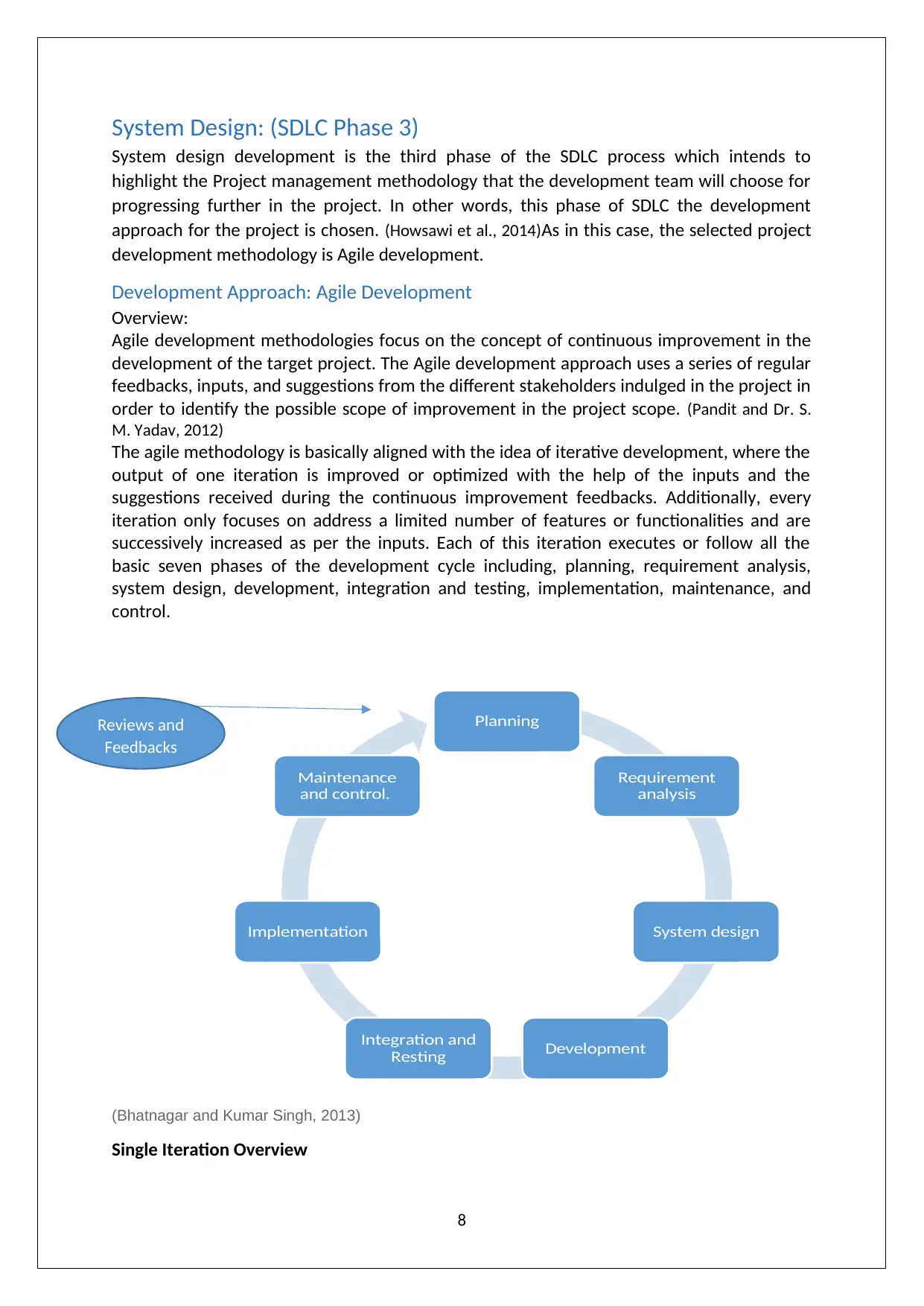
System Design: (SDLC Phase 3)
System design development is the third phase of the SDLC process which intends to
highlight the Project management methodology that the development team will choose for
progressing further in the project. In other words, this phase of SDLC the development
approach for the project is chosen. (Howsawi et al., 2014)As in this case, the selected project
development methodology is Agile development.
Development Approach: Agile Development
Overview:
Agile development methodologies focus on the concept of continuous improvement in the
development of the target project. The Agile development approach uses a series of regular
feedbacks, inputs, and suggestions from the different stakeholders indulged in the project in
order to identify the possible scope of improvement in the project scope. (Pandit and Dr. S.
M. Yadav, 2012)
The agile methodology is basically aligned with the idea of iterative development, where the
output of one iteration is improved or optimized with the help of the inputs and the
suggestions received during the continuous improvement feedbacks. Additionally, every
iteration only focuses on address a limited number of features or functionalities and are
successively increased as per the inputs. Each of this iteration executes or follow all the
basic seven phases of the development cycle including, planning, requirement analysis,
system design, development, integration and testing, implementation, maintenance, and
control.
(Bhatnagar and Kumar Singh, 2013)
Single Iteration Overview
8
Planning
Requirement
analysis
System design
Development
Integration and
Resting
Implementation
Maintenance
and control.
Reviews and
Feedbacks
System design development is the third phase of the SDLC process which intends to
highlight the Project management methodology that the development team will choose for
progressing further in the project. In other words, this phase of SDLC the development
approach for the project is chosen. (Howsawi et al., 2014)As in this case, the selected project
development methodology is Agile development.
Development Approach: Agile Development
Overview:
Agile development methodologies focus on the concept of continuous improvement in the
development of the target project. The Agile development approach uses a series of regular
feedbacks, inputs, and suggestions from the different stakeholders indulged in the project in
order to identify the possible scope of improvement in the project scope. (Pandit and Dr. S.
M. Yadav, 2012)
The agile methodology is basically aligned with the idea of iterative development, where the
output of one iteration is improved or optimized with the help of the inputs and the
suggestions received during the continuous improvement feedbacks. Additionally, every
iteration only focuses on address a limited number of features or functionalities and are
successively increased as per the inputs. Each of this iteration executes or follow all the
basic seven phases of the development cycle including, planning, requirement analysis,
system design, development, integration and testing, implementation, maintenance, and
control.
(Bhatnagar and Kumar Singh, 2013)
Single Iteration Overview
8
Planning
Requirement
analysis
System design
Development
Integration and
Resting
Implementation
Maintenance
and control.
Reviews and
Feedbacks
⊘ This is a preview!⊘
Do you want full access?
Subscribe today to unlock all pages.

Trusted by 1+ million students worldwide
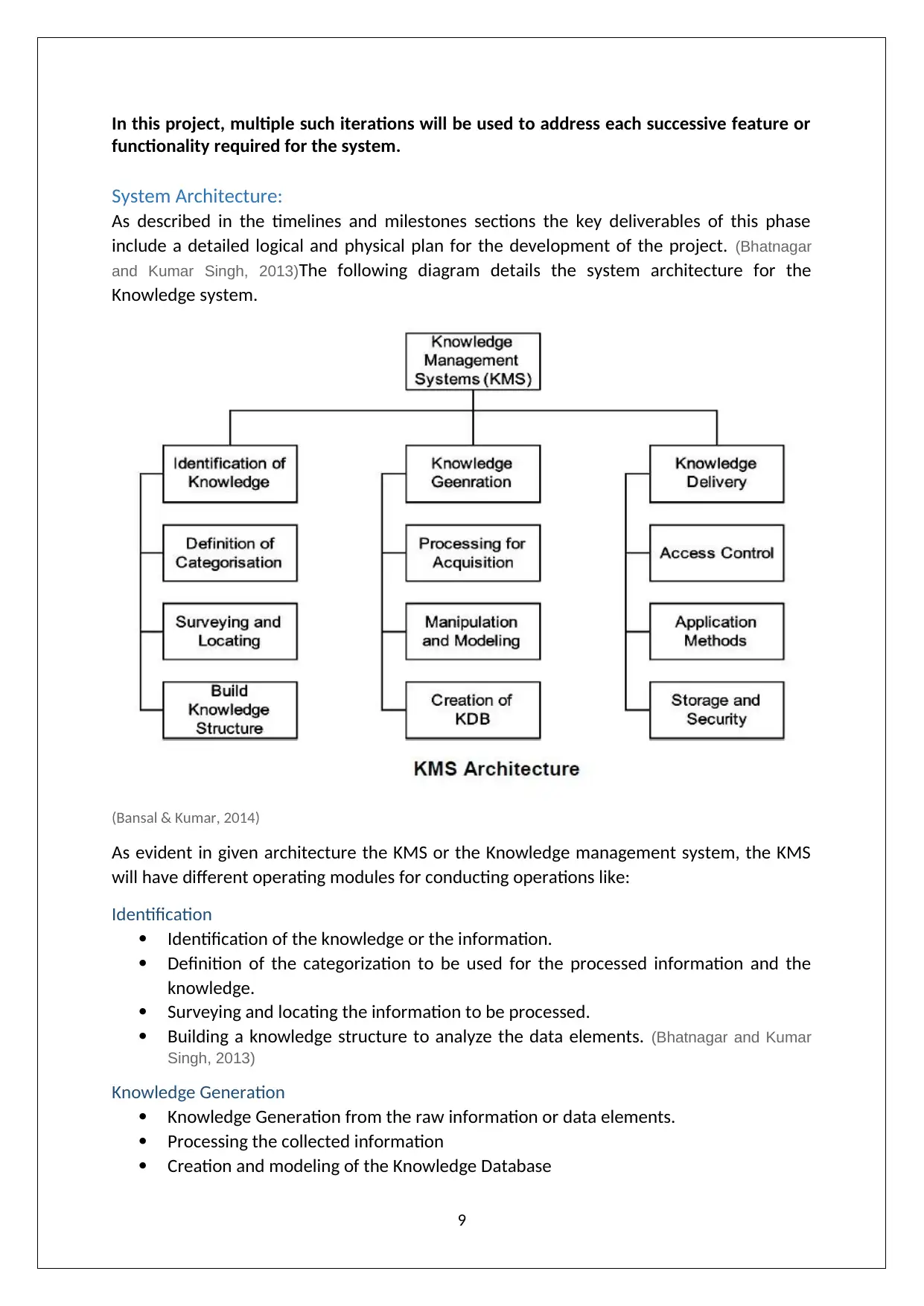
In this project, multiple such iterations will be used to address each successive feature or
functionality required for the system.
System Architecture:
As described in the timelines and milestones sections the key deliverables of this phase
include a detailed logical and physical plan for the development of the project. (Bhatnagar
and Kumar Singh, 2013)The following diagram details the system architecture for the
Knowledge system.
(Bansal & Kumar, 2014)
As evident in given architecture the KMS or the Knowledge management system, the KMS
will have different operating modules for conducting operations like:
Identification
Identification of the knowledge or the information.
Definition of the categorization to be used for the processed information and the
knowledge.
Surveying and locating the information to be processed.
Building a knowledge structure to analyze the data elements. (Bhatnagar and Kumar
Singh, 2013)
Knowledge Generation
Knowledge Generation from the raw information or data elements.
Processing the collected information
Creation and modeling of the Knowledge Database
9
functionality required for the system.
System Architecture:
As described in the timelines and milestones sections the key deliverables of this phase
include a detailed logical and physical plan for the development of the project. (Bhatnagar
and Kumar Singh, 2013)The following diagram details the system architecture for the
Knowledge system.
(Bansal & Kumar, 2014)
As evident in given architecture the KMS or the Knowledge management system, the KMS
will have different operating modules for conducting operations like:
Identification
Identification of the knowledge or the information.
Definition of the categorization to be used for the processed information and the
knowledge.
Surveying and locating the information to be processed.
Building a knowledge structure to analyze the data elements. (Bhatnagar and Kumar
Singh, 2013)
Knowledge Generation
Knowledge Generation from the raw information or data elements.
Processing the collected information
Creation and modeling of the Knowledge Database
9
Paraphrase This Document
Need a fresh take? Get an instant paraphrase of this document with our AI Paraphraser
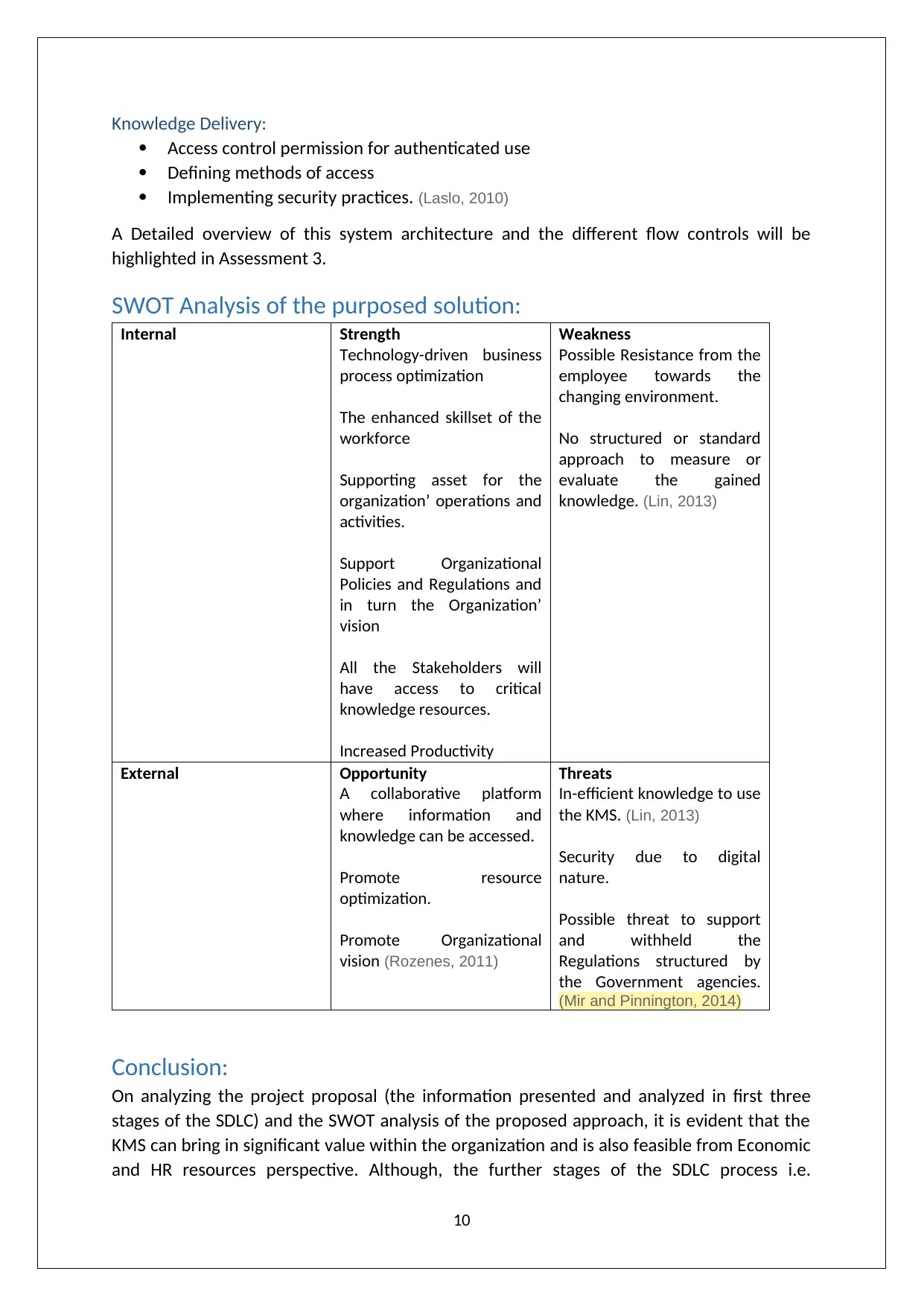
Knowledge Delivery:
Access control permission for authenticated use
Defining methods of access
Implementing security practices. (Laslo, 2010)
A Detailed overview of this system architecture and the different flow controls will be
highlighted in Assessment 3.
SWOT Analysis of the purposed solution:
Internal Strength
Technology-driven business
process optimization
The enhanced skillset of the
workforce
Supporting asset for the
organization’ operations and
activities.
Support Organizational
Policies and Regulations and
in turn the Organization’
vision
All the Stakeholders will
have access to critical
knowledge resources.
Increased Productivity
Weakness
Possible Resistance from the
employee towards the
changing environment.
No structured or standard
approach to measure or
evaluate the gained
knowledge. (Lin, 2013)
External Opportunity
A collaborative platform
where information and
knowledge can be accessed.
Promote resource
optimization.
Promote Organizational
vision (Rozenes, 2011)
Threats
In-efficient knowledge to use
the KMS. (Lin, 2013)
Security due to digital
nature.
Possible threat to support
and withheld the
Regulations structured by
the Government agencies.
(Mir and Pinnington, 2014)
Conclusion:
On analyzing the project proposal (the information presented and analyzed in first three
stages of the SDLC) and the SWOT analysis of the proposed approach, it is evident that the
KMS can bring in significant value within the organization and is also feasible from Economic
and HR resources perspective. Although, the further stages of the SDLC process i.e.
10
Access control permission for authenticated use
Defining methods of access
Implementing security practices. (Laslo, 2010)
A Detailed overview of this system architecture and the different flow controls will be
highlighted in Assessment 3.
SWOT Analysis of the purposed solution:
Internal Strength
Technology-driven business
process optimization
The enhanced skillset of the
workforce
Supporting asset for the
organization’ operations and
activities.
Support Organizational
Policies and Regulations and
in turn the Organization’
vision
All the Stakeholders will
have access to critical
knowledge resources.
Increased Productivity
Weakness
Possible Resistance from the
employee towards the
changing environment.
No structured or standard
approach to measure or
evaluate the gained
knowledge. (Lin, 2013)
External Opportunity
A collaborative platform
where information and
knowledge can be accessed.
Promote resource
optimization.
Promote Organizational
vision (Rozenes, 2011)
Threats
In-efficient knowledge to use
the KMS. (Lin, 2013)
Security due to digital
nature.
Possible threat to support
and withheld the
Regulations structured by
the Government agencies.
(Mir and Pinnington, 2014)
Conclusion:
On analyzing the project proposal (the information presented and analyzed in first three
stages of the SDLC) and the SWOT analysis of the proposed approach, it is evident that the
KMS can bring in significant value within the organization and is also feasible from Economic
and HR resources perspective. Although, the further stages of the SDLC process i.e.
10
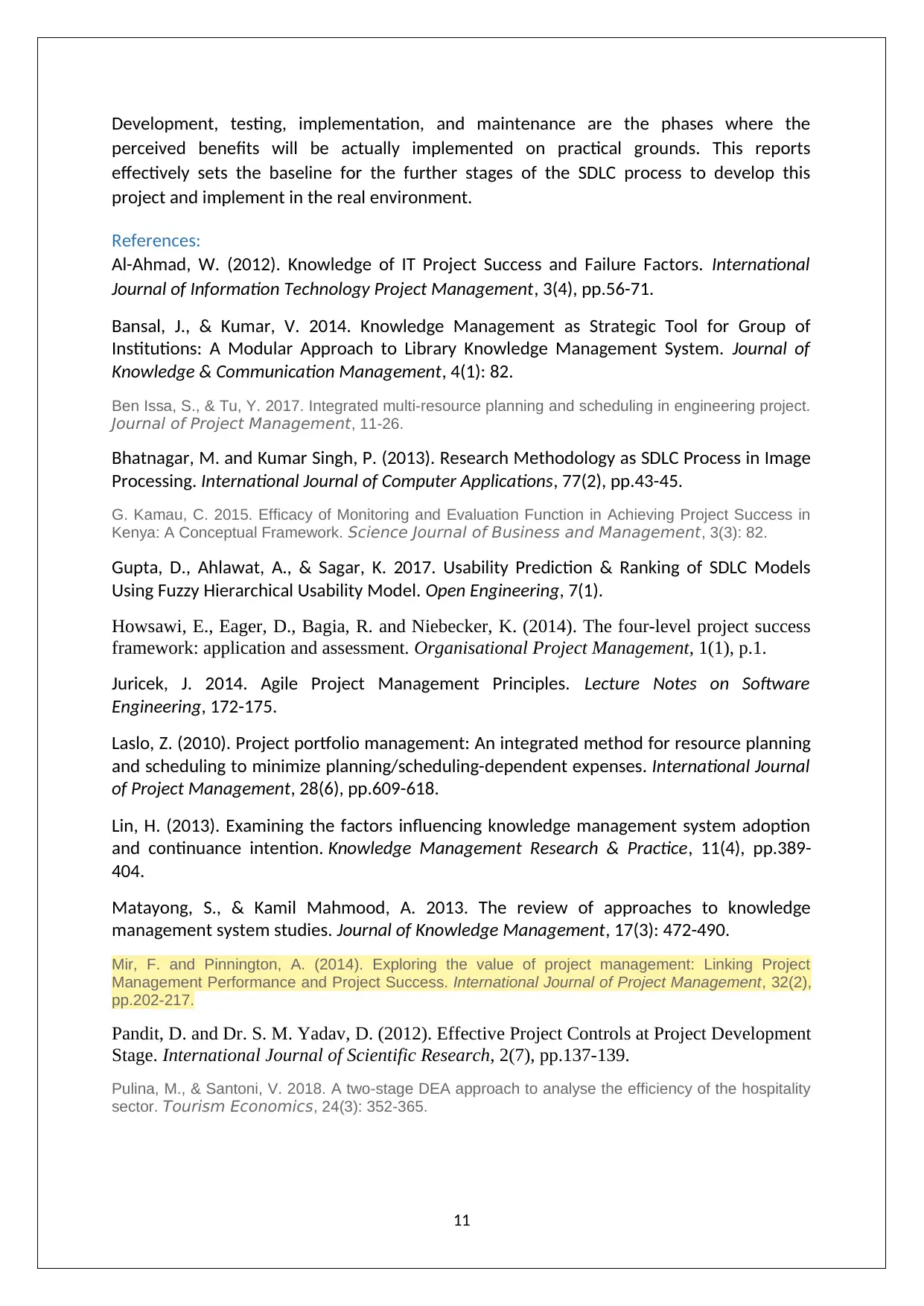
Development, testing, implementation, and maintenance are the phases where the
perceived benefits will be actually implemented on practical grounds. This reports
effectively sets the baseline for the further stages of the SDLC process to develop this
project and implement in the real environment.
References:
Al-Ahmad, W. (2012). Knowledge of IT Project Success and Failure Factors. International
Journal of Information Technology Project Management, 3(4), pp.56-71.
Bansal, J., & Kumar, V. 2014. Knowledge Management as Strategic Tool for Group of
Institutions: A Modular Approach to Library Knowledge Management System. Journal of
Knowledge & Communication Management, 4(1): 82.
Ben Issa, S., & Tu, Y. 2017. Integrated multi-resource planning and scheduling in engineering project.
Journal of Project Management, 11-26.
Bhatnagar, M. and Kumar Singh, P. (2013). Research Methodology as SDLC Process in Image
Processing. International Journal of Computer Applications, 77(2), pp.43-45.
G. Kamau, C. 2015. Efficacy of Monitoring and Evaluation Function in Achieving Project Success in
Kenya: A Conceptual Framework. Science Journal of Business and Management, 3(3): 82.
Gupta, D., Ahlawat, A., & Sagar, K. 2017. Usability Prediction & Ranking of SDLC Models
Using Fuzzy Hierarchical Usability Model. Open Engineering, 7(1).
Howsawi, E., Eager, D., Bagia, R. and Niebecker, K. (2014). The four-level project success
framework: application and assessment. Organisational Project Management, 1(1), p.1.
Juricek, J. 2014. Agile Project Management Principles. Lecture Notes on Software
Engineering, 172-175.
Laslo, Z. (2010). Project portfolio management: An integrated method for resource planning
and scheduling to minimize planning/scheduling-dependent expenses. International Journal
of Project Management, 28(6), pp.609-618.
Lin, H. (2013). Examining the factors influencing knowledge management system adoption
and continuance intention. Knowledge Management Research & Practice, 11(4), pp.389-
404.
Matayong, S., & Kamil Mahmood, A. 2013. The review of approaches to knowledge
management system studies. Journal of Knowledge Management, 17(3): 472-490.
Mir, F. and Pinnington, A. (2014). Exploring the value of project management: Linking Project
Management Performance and Project Success. International Journal of Project Management, 32(2),
pp.202-217.
Pandit, D. and Dr. S. M. Yadav, D. (2012). Effective Project Controls at Project Development
Stage. International Journal of Scientific Research, 2(7), pp.137-139.
Pulina, M., & Santoni, V. 2018. A two-stage DEA approach to analyse the efficiency of the hospitality
sector. Tourism Economics, 24(3): 352-365.
11
perceived benefits will be actually implemented on practical grounds. This reports
effectively sets the baseline for the further stages of the SDLC process to develop this
project and implement in the real environment.
References:
Al-Ahmad, W. (2012). Knowledge of IT Project Success and Failure Factors. International
Journal of Information Technology Project Management, 3(4), pp.56-71.
Bansal, J., & Kumar, V. 2014. Knowledge Management as Strategic Tool for Group of
Institutions: A Modular Approach to Library Knowledge Management System. Journal of
Knowledge & Communication Management, 4(1): 82.
Ben Issa, S., & Tu, Y. 2017. Integrated multi-resource planning and scheduling in engineering project.
Journal of Project Management, 11-26.
Bhatnagar, M. and Kumar Singh, P. (2013). Research Methodology as SDLC Process in Image
Processing. International Journal of Computer Applications, 77(2), pp.43-45.
G. Kamau, C. 2015. Efficacy of Monitoring and Evaluation Function in Achieving Project Success in
Kenya: A Conceptual Framework. Science Journal of Business and Management, 3(3): 82.
Gupta, D., Ahlawat, A., & Sagar, K. 2017. Usability Prediction & Ranking of SDLC Models
Using Fuzzy Hierarchical Usability Model. Open Engineering, 7(1).
Howsawi, E., Eager, D., Bagia, R. and Niebecker, K. (2014). The four-level project success
framework: application and assessment. Organisational Project Management, 1(1), p.1.
Juricek, J. 2014. Agile Project Management Principles. Lecture Notes on Software
Engineering, 172-175.
Laslo, Z. (2010). Project portfolio management: An integrated method for resource planning
and scheduling to minimize planning/scheduling-dependent expenses. International Journal
of Project Management, 28(6), pp.609-618.
Lin, H. (2013). Examining the factors influencing knowledge management system adoption
and continuance intention. Knowledge Management Research & Practice, 11(4), pp.389-
404.
Matayong, S., & Kamil Mahmood, A. 2013. The review of approaches to knowledge
management system studies. Journal of Knowledge Management, 17(3): 472-490.
Mir, F. and Pinnington, A. (2014). Exploring the value of project management: Linking Project
Management Performance and Project Success. International Journal of Project Management, 32(2),
pp.202-217.
Pandit, D. and Dr. S. M. Yadav, D. (2012). Effective Project Controls at Project Development
Stage. International Journal of Scientific Research, 2(7), pp.137-139.
Pulina, M., & Santoni, V. 2018. A two-stage DEA approach to analyse the efficiency of the hospitality
sector. Tourism Economics, 24(3): 352-365.
11
⊘ This is a preview!⊘
Do you want full access?
Subscribe today to unlock all pages.

Trusted by 1+ million students worldwide
1 out of 14
Your All-in-One AI-Powered Toolkit for Academic Success.
+13062052269
info@desklib.com
Available 24*7 on WhatsApp / Email
![[object Object]](/_next/static/media/star-bottom.7253800d.svg)
Unlock your academic potential
Copyright © 2020–2025 A2Z Services. All Rights Reserved. Developed and managed by ZUCOL.


